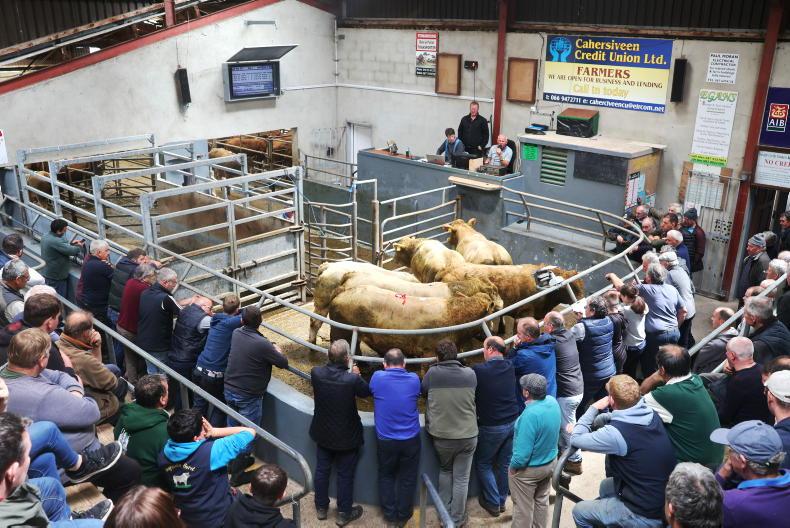All eyes are on the autumn weanling trade and what affect the current slide in beef prices will have on the all-important autumn trading. August, September and October are by far the busiest months for weanling trading, and with weather still not playing ball in many parts of the country, weanlings could come out earlier in 2023.
There is no doubt that a reduced beef price has affected the mart trade. If we look at the average R3 bullock price for the first week of August 2022, we were sitting at €5.07/kg, while 12 months later this price has dropped to €4.98/kg, an almost 10 cent/kg drop. While some stability has entered the trade this week, there are fears of further drops between now and winter housing in October/November. The reduced beef price has seen the mart trade ease for heavy, slaughter-fit cattle and it also seems to have dented some confidence in the weanling trade.
Live exports have been very strong during the first half of 2023, with 258,838 head of cattle exported out of Ireland up to the end of July 2023, a rise of almost 37,000 head, or 17%, on the same period in 2022.
Despite disruption to the calf trade in spring 2023, huge numbers moved to central Europe. According to Bord Bia figures, a total of 202,273 calves have been exported so far in 2023, with Spain, Netherlands and Italy still the most important European markets for Irish calves.
Weanling exports have also been performing well in 2023, with steady demand for younger cattle in key European markets and further afield – where contacting cattle herds have increased demand for live cattle. There were high hopes for a very good autumn trade to Turkey, but a change in government has led to currency issues – which has seen the value of the Turkish lira fall which will weaken the hand of importers.
Turkey has a big demand though and it’s hoped that Ireland can capitalise on that. After a relatively strong start to the year, the trading of older categories of cattle hasn’t seen the height of 2021 or 2022. There have, however, been some indications of improving demand for Irish cattle in Northern Ireland in recent weeks, with a higher beef price north of the border, meaning these customers are very strong when buying in southern marts.
Prices
While the 2022 verus 2021 comparison this time last year was a positive one, this year’s analysis doesn’t paint as positive a picture for the autumn cattle trade. In the most popular 300-400kg weight bracket, top-quality weanling bulls are up €49/head on last year’s trading. Average-quality bulls in the same weight bracket are up €56/head, while the lower-end (mostly made up of dairy-beef weanlings) are up the most at €63/head. Heavier bull weanlings haven’t gotten off to as good a start in 2023. Bull beef prices have taken a hit and this has filtered down to the weanling ring, with prices back on where they were 12 months ago.
Taking a look at the top-quality category, a 425kg bull weanling is coming in at €1,275 this year, a drop of €55/head on last year. Average bulls in the same weight category came in at €1,148/head, back €42/head on last year, while poorer-quality bulls in the same weight category came in at €1,024/head, back €26/head on last year.
Weanling heifers have seen a bigger drop in price compared to last year. Weanling heifers are bought by farmer buyers and smaller finishers not having the insulation of a contract that some of the larger bull finishers would have.
Top-end heifer weanlings in the 300-400kg weight bracket are back by €71/head to €1,053/head. Average-quality weanlings saw a slight improvement, coming in at €956/head, up €4/head on last year, while the poorer-quality dairy-cross weanlings saw a lift in price coming in €52/head higher than August 2022.
Heavier weanling heifers have seen better demand, with all quality categories up in price for the 400-450kg heifer weanling.
Top-end, heavier weanling heifers are up €38/head to €1,288/head. Average-quality heifers in the same weight category came in at €1,182/head, a lift of €64/head on 2022, while poorer -quality dairy-cross heifers saw a rise of €72/head to come in at €1,067 for a 425kg heifer.
Moving to the lighter bullock rings, top-end bullocks in the 400-500kg weight category came in at €59/head more than the previous year, at €1,292/head. Average-quality lighter bullocks saw a €20/head increase. Poorer-quality bullocks have seen a price decrease, with these back €41/head to €837/head, compared to last year.
Heavier bullocks have also taken a hit, with all-quality categories back in price on where we were 12 months ago. This is reflective of the over 50c/kg price cuts that factories have applied to farmers over the last three months.
Top-end 600kg bullocks were back by €72/head to €1,644/head. Average-quality bullocks took one of the biggest drops of all cattle, decreasing by €84/head to €1,452/head. Poorer-quality heavy bullocks were back by €72/head to €1,272/head.
In the store heifer ring, top-end 400-500kg heifers came in at €1,238, a drop of €27/head on last year. Average-quality heifers in the same weight bracket were back by €26/head, while poorer-quality heifers were back by €27/head to €954/head. Heavier heifers over 600kg have seen the biggest fall on 12 months ago. Top-end heavy heifers came in at €1,620/head, a fall of €114/head on last year. Average heifers were back by €108/head to €1,476/head, while dairy-cross heifers were back by €96/head on last year’s trading.
Martbids
From 31 August, we will be increasing our weekly coverage from marts to four pages every week. This will include the popular Weanling Watch, which will cover special sales of weanlings over the next few months. We will also have the Martbids analysis table back in print, which summarises thousands of real-time prices from marts around the country. Online mart reports can also be accessed on www.farmersjoural.ie






 This is a subscriber-only article
This is a subscriber-only article










SHARING OPTIONS: